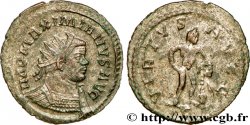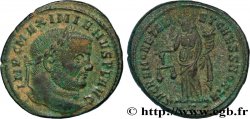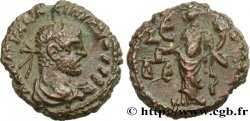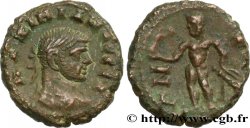brm_589549 - MAXIMIANUS HERCULIUS Aurelianus
Not available.
Item sold on our e-shop (2021)
Price : 150.00 €
Item sold on our e-shop (2021)
Price : 150.00 €
Type : Aurelianus
Date: printemps 290-291
Date: 290-291
Mint name / Town : Lyon
Metal : billon
Millesimal fineness : 50 ‰
Diameter : 22,5 mm
Orientation dies : 6 h.
Weight : 3,71 g.
Rarity : R2
Officine: 2e
Coments on the condition:
Exemplaire de qualité exceptionnelle au droit, bien centré des deux côtés. Très beau buste consulaire. Frappe molle et faible au revers. Patine marron avec des reflets métalliques. Conserve au droit son coupant d’origine et son brillant de frappe
Catalogue references :
Obverse
Obverse legend : IMP MAXIMIANVS AVG.
Obverse description : Buste consulaire radié de Maximien Hercule à gauche, tenant le scipio de la main droite, vu de trois quarts en avant (H2).
Obverse translation : “Imperator Maximianus Augustus”, (L'empereur Maximien auguste).
Reverse
Reverse legend : PAX - A-VGG/ -|-// B.
Reverse description : Pax (la Paix) debout à gauche, tenant un globe nicéphore de la main droite et un sceptre transversal de la main gauche.
Reverse translation : “Pax Augustorum”, (La Paix des augustes).
Commentary
Avec son argenture superficielle. Rubans de type 3. Manteau consulaire richement décoré avec la toga picta et la toga palmata. Cet exemplaire présente un cas intéressant de retouche de légende avec les lettres DIOCLET sous MAXIM. Ces cas de modifications de légende sans être courant se rencontrent quand on y prête attention. Daniel Gricourt, Aureliani de l’atelier de Lyon sous l’empereur Dioclétien : enquête et données nouvelles, RBN. CXXX, 1984, p. 68, n° 8, pl. III signalait un cas similaire pour la septième émission et fournissait quelques hypothèses de travail, RBN 1984, op. cit., p. 97-99 dans “Questions d’épigraphie et d’iconographie monétaires”.








 Report a mistake
Report a mistake Print the page
Print the page Share my selection
Share my selection Ask a question
Ask a question Consign / sell
Consign / sell
 Full data
Full data



